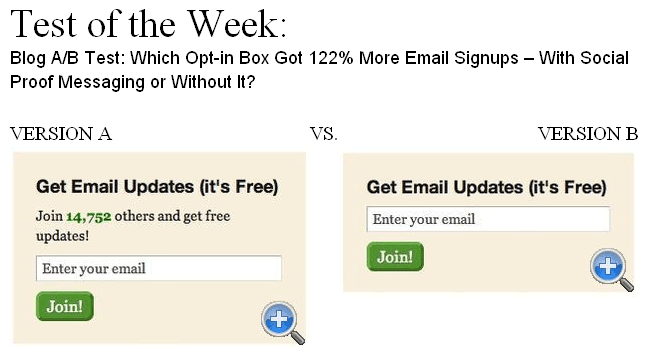
This test was featured on Anne Hollands Which Test Won. The only difference between Version A and Version B was the addition of the phrase “Join 14,752 others and get free updates!” under the headline in Version A.
Spoiler Alert: Version B was the winner. Most marketers, 78% of them believed that version A would outperform the winning version B. If this is not a reason to test I don’t know what is.
Here’s my analysis on the winner:
The question this test is asking is: Which version will get more email signups? The variable for this test is the social proof copy, “Join 14,752 others and get free updates!” used in version A, and eliminated in version B.
Usually adding social proof increases conversion rates, however in this case it’s clearly not the best with the non social proof version winning with 122% increase in eMail opt-ins. Here’s why I think it failed in this case. To be effective social proof needs to come from some one you know and trust. Or be from a peer group that is as close to people you know and trust as they can be in an online situation. You need to identify with the group in order to be influenced. The social proof copy is simply that 14,752 have also joined. This lacks the power of peer to peer social proof and is simply a minor use of the principal. The prospect in this case has not yet identified with the group for this to be effective. To increase the power of social proof here there are a few supportive elements that can add to peer influence, such as photos of some people who have joined, short testimonials. In this case just a simple number is not enough of an influencer to move the needle.
Best of luck on follow up tests.
Discover the 3 funnels that can help your health supplement business succeed.

Listen to the Health Supplement Business Mastery Podcast for for dietary supplement entrepreneurs and marketers.




Fascinating results – thanks for posting! I would have guessed that the social proof would have had a slight lift (and at worst a slight decrease), but never a huge decrease.
My guess would be that the huge difference in results is about something more than ineffective social proof. Something else must be going on. Perhaps visitors thought that there was more commitment involved on their part than just getting an email – e.g. do they think that they are actually joining something? Subconsciously, that sounds like a lot of work and may turn them off.
Of course, this is just a guess and my last guess was wrong…
Your welcome Ben, That’s an interesting hypothesis about joining leading to a bigger commitment. Either way you are correct in your analysis there is more going on in the mind of the prospect here and there is defiantly some anxiety that has not been mitigated. At least, that’s my hypothesis.